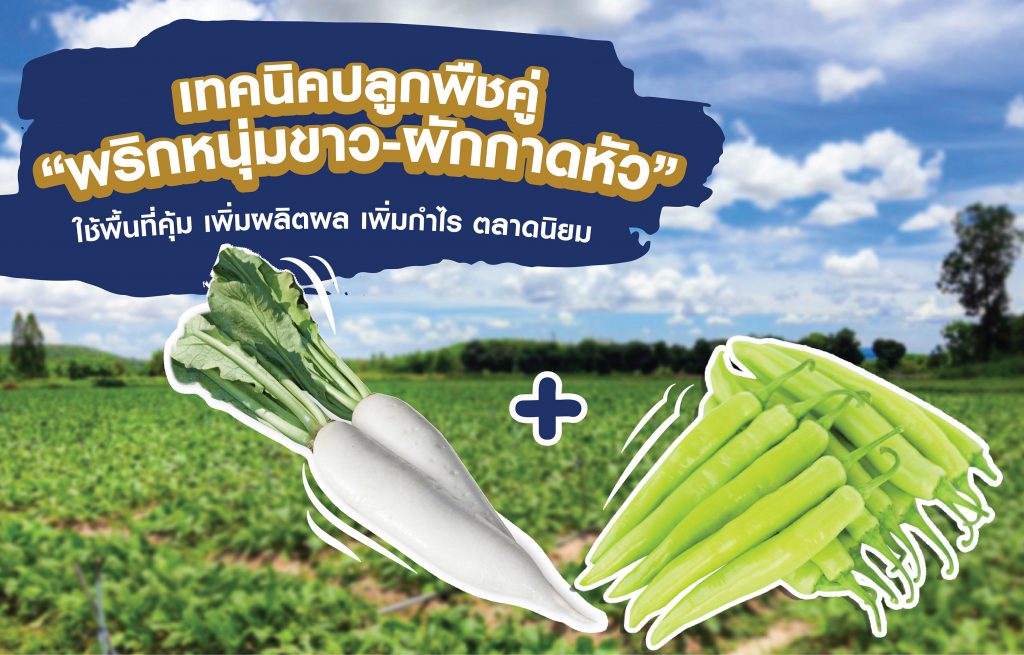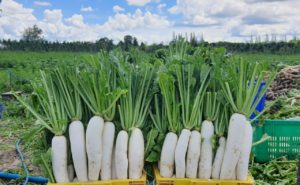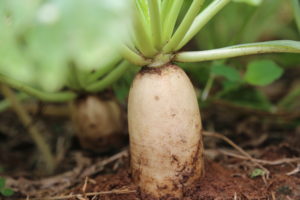- Home
- News and Promotion
- News
- Guide to “Hot Pepper-Radish” double cropping technique Providing space usage optimization, more outputs, more profits, favorable market demands
Guide to “Hot Pepper-Radish” double cropping technique Providing space usage optimization, more outputs, more profits, favorable market demands

Bangkok, September 6, 2021 – Vegetables like hot pepper and radish are considered one of the cash crops which has garnered the interest of many people who would opt to grow largely in Pak Chong district, Nakhon Ratchasima province. The size of the harvested produce is well in response to market expectation, stable prices as well as the strong stem. Hence, the farmed vegetables are regarded worthwhile for investment, well clicked with farmers and popularly up to consumer’s dining choice.
In the meantime, it is within one of the cultivating seasons for hot pepper and radish especially in the main areas such as Pak Chong district in Nakhon Ratchasima province, where most farmers prefer to grow multiple kinds of vegetables in same plantations to enable rotations and able to reap harvests of outputs throughout the cultivating seasons. This is thus deemed the cost-effective method in space usage. In this connection, Mr. Kittisak Kittiwuthcharoenkul, alias Brother Chen, a farmer in Pak Chong district, Nakhon Ratchasima province, would share his double cropping technique in growing “Hot Pepper-Radish” to achieve successes and robust profits. He has more than 10 years of cultivation experience on a plot of more than 50 rai of which about 40 rai are allotted to planting radish mainly of Everest variety, 5 rai for Yok Thep hot pepper while the rest for alternate seasonal vegetables.

Methods in growing Yok Thep hot pepper to achieve high outputs, attractive shape, favorable market demands
Plot Preparation
- In the first phase, it is necessary to stimulate the bush of Yok Thep hot pepper to enlarge in shape and in height so as to enable larger number of branches and prolific outputs, as a result.
- The planting gap should have a distance between each plant and row at 50 x 50 cm, when plot preparation and drilled planting holes are ready, the bottom of drilled holes should be placed with manure or compost fertilizer or may also add some pesticides well-mixed with soil to the bottom of drilled holes to prevent and destroy pests.
- For plot preparation, if the soil is very acidic then lime should be applied to improve soil conditions to be suitable for growing peppers.
Staking the plant
- In growing Yok Thep hot pepper, staking is required to help support branches and stems from damage due to breaking especially in the beginning of pepper fruiting period and should be done prior to pepper blooming, which may be via staking all plants and tie each branch together, or may use rope to pull lengthwise of the plot to help support branches not to break, which can be done by staking all plants and staking the entire row lengthwise of the plot, as needed.
Fertilizing
- Seedling period: 0 – 25 days
Apply granular fertilizer before growing using 15-15-15 formula and 20-25kg per rai.
- After transplant of seedlings period: 5-7 days after transplant of seedlings or leaf nourishing period
Apply fertilizer 16-16-16 Blue and 30-50kg per rai. In case of fertilizing together with drip irrigation system, apply fertilizer every other day. - After transplanting period: 15-20 days after transplant of seedlings or flower nourishing period
Apply fertilizer 9-25-25 formula in the quantity of 20-30kg per rai by drilling holes between pepper plants. In case of fertilizing together with drip irrigation system, apply fertilizer every other day. - Pepper fruiting period: 50-60 days after transplant of seedlings or produce nourishing period
Apply fertilizer 13-13-24 formula in the quantity of 25-30kg per rai. In case of fertilizing together with drip irrigation system, apply fertilizer every other day. - Harvesting period: 60-75 days
To begin harvesting, consider fertilizing as appropriate by using 16-16-16 Blue alternating with 13-13-24 or 15-9-20 and use 16-16-16 Blue when the stem starts to be shabby.
- After harvesting: apply fertilizer 13-13-24 formula or 15-9-20 when the plant has mature leaves pending to yield outputs.
Another important tip of Brother Chen in growing Yok Thep hot pepper is the supply of water by way of sprinkler. Normally, some people will supply water by way of drip irrigation system but Brother Chen said, “Watering via sprinkler is better than drip irrigation system because the former will help wash the leaves, clean the shoots, and get rid of insects if the plant is found to have insects and it can also help reduce the happening of diseases. In essence, it increases soil moisture prompting water to evaporate slower by watering twice a day, i.e., late in the morning and in the afternoon.”
Everyday Brother Chen will regularly check and tend to Yok Thep hot pepper plots to see whether or not there is any disease or insect, including the removal of grass and weeds at the base of the plant to reduce the diseases. By choosing good quality seeds like hot pepper seeds of Chia Tai’s Yok Thep variety, which is the most helpful part as evidenced by its strong variety, disease tolerance and able to reap harvests in longer duration while the derived outputs are consistently in good quality from every harvest hence it has high demands in the market. The importance rests with its very strong stem whereas normally the stems of other varieties are about knee-high while Yok Thep hot pepper is waist-high prompting in high outputs, more prolific fruiting and attractive color, firm texture, and durable in the course of transportation.

Plot Preparation
- Raise the trench, 1.2 m in width and 30 cm in height Give 50 cm space for walkway between grooves.

- Sow 1 seed per hole Give 20 cm space for gap between plants and watering moderately while in certain situation, use straw to cover the hole to maintain moisture.
Watering
- Give watering at least once a day to maintain soil moisture, or up to weather condition.
Do not let radish to run short of water as this will affect its head to be imperfect in size which does not match the desirable quality of the market.
The important tips in growing Everest hybrid radish are the environmental and weather conditions. The soil should be loam or sandy loam, avoid planting on ultra-clayed soil because hard soil will hinder radish to thrive well. Furthermore, radish needs sunshine all day long with proper soil moisture. The most ideal weather condition is between 18-25 degrees Celsius or in winter during the months of October – February, the period to which Everest radish will thrive quickly, easy to grow and the most beautiful look of the harvested produce.

Brother Chen has concluded by saying, “The change of new packaging for Everest radish in the form of zip-lock bags has enhanced more convenience in usage, coupled with good quality seeds prompting the harvested produce to look more attractive, consistent quality, firmer texture with better weight than other varieties. Vegetable planting with Chia Tai’s variety is never a disappointment whether it is Yok Thep hot pepper or Everest radish. It is guaranteed to meet market demands and the beautiful look of the harvested produce with trusted quality.”
Interested persons can update more information on Chia Tai’s seeds and other agricultural news via Facebook: CHIA TAI SEED www.facebook.com/chiataiseed; add Line: @chiataiseed;
and Chia Tai’s website: www.chiataiseed.com





